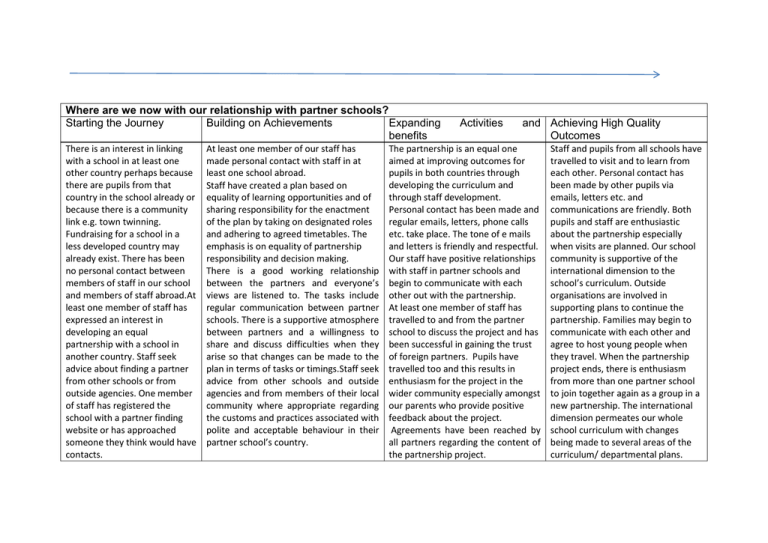Starting the Journey Building on Achievements Expanding Activities and
advertisement

Where are we now with our relationship with partner schools? Starting the Journey Building on Achievements Expanding benefits There is an interest in linking with a school in at least one other country perhaps because there are pupils from that country in the school already or because there is a community link e.g. town twinning. Fundraising for a school in a less developed country may already exist. There has been no personal contact between members of staff in our school and members of staff abroad.At least one member of staff has expressed an interest in developing an equal partnership with a school in another country. Staff seek advice about finding a partner from other schools or from outside agencies. One member of staff has registered the school with a partner finding website or has approached someone they think would have contacts. At least one member of our staff has made personal contact with staff in at least one school abroad. Staff have created a plan based on equality of learning opportunities and of sharing responsibility for the enactment of the plan by taking on designated roles and adhering to agreed timetables. The emphasis is on equality of partnership responsibility and decision making. There is a good working relationship between the partners and everyone’s views are listened to. The tasks include regular communication between partner schools. There is a supportive atmosphere between partners and a willingness to share and discuss difficulties when they arise so that changes can be made to the plan in terms of tasks or timings.Staff seek advice from other schools and outside agencies and from members of their local community where appropriate regarding the customs and practices associated with polite and acceptable behaviour in their partner school’s country. Activities and Achieving High Quality Outcomes The partnership is an equal one aimed at improving outcomes for pupils in both countries through developing the curriculum and through staff development. Personal contact has been made and regular emails, letters, phone calls etc. take place. The tone of e mails and letters is friendly and respectful. Our staff have positive relationships with staff in partner schools and begin to communicate with each other out with the partnership. At least one member of staff has travelled to and from the partner school to discuss the project and has been successful in gaining the trust of foreign partners. Pupils have travelled too and this results in enthusiasm for the project in the wider community especially amongst our parents who provide positive feedback about the project. Agreements have been reached by all partners regarding the content of the partnership project. Staff and pupils from all schools have travelled to visit and to learn from each other. Personal contact has been made by other pupils via emails, letters etc. and communications are friendly. Both pupils and staff are enthusiastic about the partnership especially when visits are planned. Our school community is supportive of the international dimension to the school’s curriculum. Outside organisations are involved in supporting plans to continue the partnership. Families may begin to communicate with each other and agree to host young people when they travel. When the partnership project ends, there is enthusiasm from more than one partner school to join together again as a group in a new partnership. The international dimension permeates our whole school curriculum with changes being made to several areas of the curriculum/ departmental plans.





